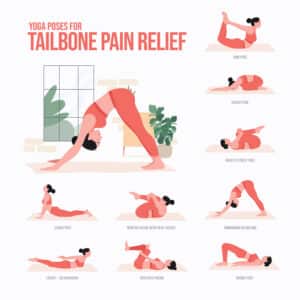Coccydynia
Coccydynia, also known as coccyalgia, refers to pain and inflammation of the coccyx (tailbone), the final segment of the spine, located between the buttocks. Patients suffering from coccydynia experience pain on the tailbone that is especially pronounced when sitting or when engaged in any activity that puts pressure on the site.
The coccyx is the terminal segment of the spine that consists of 3 to 5 fused bone segments. It attaches to sacrum with sacrococcygeal ligament. Coccyx has several important functions. It acts as the insertion site for multiple muscles, ligaments, and tendons, which help support the pelvic floor and also contribute voluntary bowel control. Coccyx also serves as one leg of the tripod, and along with the ischial tuberosities, provides weight-bearing support to a person in the seated position. Coccyx also provides positional support to the anus.

Coccygeal Plexus
Coccyx receives nerve supply from a network of nerves, the coccygeal plexus (Courtesy of Dr Matt Skalski, Radiopaedia.org. From the case rID: 63690). Blocking coccygeal nerves or coccygeal plexus has been shown to help with coccydynia or tailbone pain.

Ganglion of Impar (Courtesy: Asian Journal of Neurosurgery)
In addition, the pelvic portion of each sympathetic trunks converge and end on the front of the coccyx in a small ganglion, the ganglion impar, also known as azygos or ganglion of Walther. There is a strong evidence that this bundle of nerves also carries pain signals in cases of coccydynia. Blocking coccygeal nerves (or coccygeal plexus) along with the ganglion of impar, has been shown to help with coccydynia or tailbone pain. Imaging guidance, such as fluoroscopy, is absolutely recommended for injections around the coccyx because of its position relative to other vital structures.
Causes Of Coccydynia
Most frequently, coccydynia is the result of a traumatic injury, such as may occur during a fall or a particularly difficult birthing experience. It may also be caused by repeated stress to the area, such as that which occurs during horseback riding or bicycling. In some cases, the condition may be idiopathic, meaning that it has no known cause. Several medical problems may mimic coccydynia, including pilonidal cysts, sciatica, and shingles. On rare occasions, coccydynia may result from an infection or a tumor. When a patient presents with coccydynia, it is important to rule out other causes of the pain, including a fracture of the coccyx.
Obesity and female gender are often cited as predisposing factors to develop tailbone pain. Women are 5 times more likely to develop coccydynia than men. Presumably, rapid weight loss can also be a risk factor because of the loss of mechanical cushioning.
Symptoms Of Coccydynia
Patients with coccydynia experience more intense pain when involved in any activity that puts increased pressure on the coccyx, including sitting on a hard surface, bicycling or horseback riding. Patients may also experience pain when constipated, straining during a bowel movement or during sexual intercourse.
Diagnosis Of Coccydynia
Coccydynia is usually diagnosed through a simple physical examination. In most cases, however, imaging tests, such as X-rays, or CT or MRI scans, are necessary to rule out other causes of the patient’s complaints.
Treatment Of Coccydynia
Conservative treatment is successful in 90% of coccydynia cases. Relatively simple measures like a modified wedge-shaped cushions (coccygeal cushions) or circular cushions (donut cushions) have been suggested for the treatment of coccydynia. Coccygeal cushions can relieve the pressure on the coccyx while the patient is seated. Donut cushions can place pressure on the coccyx by isolating the coccyx and ischial tuberosities and are more useful for treating rectal pain. Postural training, heat and cold applications and antiinflammatory medications are helpful in many cases.

For the few cases that do not respond to these conservative treatments, more aggressive treatments may be indicated. Pelvic floor rehabilitation can be helpful for coccydynia that is associated with pelvic floor muscle spasms. Manual manipulation and massage can be both diagnostic and therapeutic. Intrarectal manipulation can identify and potentially correct a dislocated sacrococcygeal joint. Manual manipulation and massage can help relieve associated muscle spasms or ligament pain.
In a handful of cases, COCCYX OR TAILBONE INJECTION (a combination of coccygeal nerve block and ganglion of impar block) has been shown to an extremely successful treatment option to resolve pain. More recently, platelet rich plasma (PRP) has been utilized in selective cases. Surgical resection of coccyx (coccygectomy) is rarely needed.


